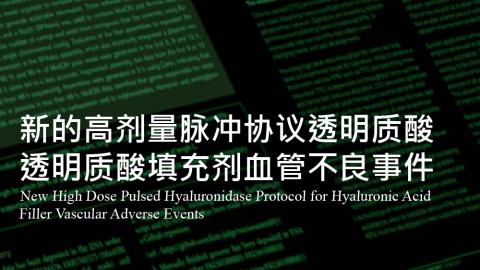
- 3079人
- 分享收藏
新的高剂量脉冲协议透明质酸透明质酸填充剂血管不良事件
New High Dose Pulsed Hyaluronidase Protocol for HA
简介
【 文献重点摘要 】
The purpose of this article is to update the changes to the author’s protocols used to manage acute filler related vascular events from those previously published in this journal. For lack of a better term, this new protocol has been called the High Dose Pulsed Hyaluronidase (HDPH) protocol for vascular embolic events with hyaluronic acid (HA) fillers. The initial protocol used involved many different modalities of treatment. The current protocol is exceedingly simple and involves solely the use of hyaluronidase in repeated high doses. Despite the simplicity of the treatment, it has proven itself to be very successful over the past two years of clinical use. There has been no partial or complete skin loss associated with this protocol since its implementation if the protocol was implemented within 2 days of the ischemic event onset. The protocol involves diagnosis and repeated administration of relatively high doses hyaluronidase (HYAL) into the ischemic tissue repeated hourly until resolution (as detected clinically through capillary refill, skin color, and absence of pain). The dosage of HYAL varies as the amount of ischemic tissue, consistent with the new underlying hypothesis that we must flood the occluded vessels with a sufficient concentration of HYAL for a sufficient period of time in order to dissolve the HA obstruction to the point where the products of hydrolysis can pass through the capillary beds. Although vascular embolic events are rare, it is important to note that the face has higher risk and lower risk areas for filler treatment, but there are no “zero risk” areas with respect to filler treatments. Even with good anatomic knowledge and correct technique, there is still some nonzero risk of vascular embolic events (including highly skilled, experienced injectors). However, with careful low pressure, low volume injection technique, and adequate preparation for treatment of acute vascular events, the risk is quite manageable and the vast majority of adverse events are very treatable with an excellent prognosis, with a few exceptions. This new protocol offers excellent results, but requires further research to determine optimal parameters for various HA fillers.
这篇文章的目的是更新作者用于管理急性填充物相关血管事件的方案的变化,而不是以前发表在本杂志上的那些变化。由于没有更好的术语,这个新的方案被称为高剂量脉冲透明质酸酶(HDPH)方案,用于使用透明质酸(HA)填充物的血管栓塞事件。最初使用的方案涉及许多不同的治疗方式。目前的方案非常简单,只涉及重复高剂量使用透明质酸酶。尽管治疗很简单,但在过去两年的临床应用中,它已经证明自己非常成功。如果该方案在缺血事件发生后2天内实施,则自实施该方案以来,没有发生与该方案相关的部分或全部皮肤脱落。该方案包括诊断和向缺血组织重复使用相对高剂量的透明质酸酶(HYAL),每小时重复一次,直到消退(临床上通过毛细血管再充盈、肤色和无痛检测到)。HYAL的剂量随缺血组织的数量而变化,这与新的基本假设一致,即我们必须向闭塞的血管注入足够浓度的HYAL足够长的时间,以溶解HA阻塞,使水解产物能够通过毛细血管床。虽然血管栓塞事件很少见,但值得注意的是,对于填充物治疗,面部有更高的风险和更低的风险区域,但对于填充物治疗来说,没有“零风险”区域。即使有良好的解剖学知识和正确的技术,仍然存在一些血管栓塞事件的非零风险(包括高技能、有经验的注射器)。然而,通过谨慎的低压、低流量注射技术,以及为治疗急性血管事件做好充分的准备,风险是相当可控的,绝大多数不良事件是非常可以治疗的,预后良好,除了少数例外。这一新的方案提供了极好的结果,但需要进一步的研究来确定各种HA填充物的最佳参数。



